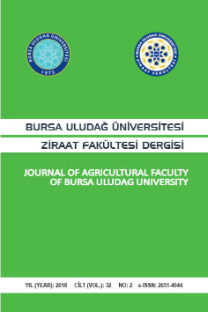Biyojen aminler-süt ve süt ürünlerindeki varlığı ve önemi
genel bakış, gıda zehirlenmesi, Türkiye, tiramin, süt ürünleri, süt, histamin, biyojenik aminler, peynir
Biogenic amines-their occurence and significance in milk and milk products
reviews, food poisoning, Turkey, tyramine, milk products, milk, histamine, biogenic amines, cheeses,
___
1.Askar, A., Treptow, H.: Biogene Amine in Lebensmitteln. Vorkommen, Bedeutung und Bestimmung, Eugen Ulmer Verlag, Stuttgart, 1986.2.Aygün, O.: Vergleichsuntersuchung zwischen Enzymimmuntests und Hochleistungsflüssigkeitschromatographie zum Nachweis von Histamin in Käse. (Doktora Tezi). Ludwig-Maximilians Universität, Tierärztliche Fakultät, München, 1998.
3.Aygün, O., Schneıder, E., Scheuer, R., Usleber, E., Gareıs, M., Martlbauer, M.: Comparison of Elisa and HPLC for the Determination of Histamine in Cheese. J. Agric. Food. Chem., 1999; 47: 1961-1964.
4.Becker, K., Southwıck, K., Reardon, J., Berg, R., MacCormack, J.N.: Histamine poisoning associated with eating tuna burgers. JAMA, 2001; 285 (10): 1327-1330.
5.Beutlıng, D.: Biogene Amine in der Ernährung. Arch. Lebensmittelhyg., 1996; 47: 97-102.
6.Fletcher, G.C., Summers, G., Van Veghel, P.W.C.: Levels of histamine and histamine-producing bacteria in smoked fish from New Zealand markets. J. Food Prot., 1998; 61: 1064-1070.
7.Galgano, F., Suzzı, G., Favatı, F., Caruso, M., Martuscellı, M., Gardını, F., Salzano, G.: Biogenic amines during ripening in 'Semicotto Caprino' cheese: role of enterococci. Int. J. Food Sci. Technol., 2001; 36 (2): 153-160.
8.Gessner, B.D., Hokama, Y., Isto, S.: Scombrotoxicosis-like illness following the ingestion of smoked salmon that demonsrated low histamine levels and high toxicity on mause bioassay. Clinical Infect. Diseases, 1996; 23: 1316-1318.
9.Grove, H.H., Terplan, G.: Erhebungen über den Histamin- und Tyramingehalt in Trockenmilchprodukten. Arch. Lebensmittelhyg., 1975; 26: 147-152.
10.Halasz, A., Barath, A., SImon-SarkadI, L., Holzapfel, W.: Biogenic amines and their production by microorganisms in food. Trends Food Sci. Technol., 1994; 5: 42-48.
11.Ijomah, P., Clıfford, M.N., Walker, R., Wrıght, J., Hardy, R., Murray, C.K.: The importance of endogenous histamine relative to dietary histamine in the aetiology of scombrotoxicosis. Food Add. Contam., 1991; 8 (4): 531-542.
12.Joosten, H.M.L.J.: The biogenic amines contents of Dutch cheese and their toxicological significance. Neth. Milk Dairy J., 1988; 42: 25-42.
13.Kankı, M., Yoda, T., Tsukamoto, T., Shıbata, T.: Klebsiella pneumoniae Produces No Histamine: Raoultella planticola and Raoultella ornithinolytica Strains Are Histamine Producers. Appl. Environm. Microbiol., 2002; 68 (7): 3462-3466.
14.Kıelweın, G.: Biogene Amine in Kase: Bildung, Vorkommen und Risikoabschätzung. 36. Tagung des Arbeitsgebietes Lebensmittelhygiene der DVG e. V. Vom 26.-29. September 1995 in Garmisch-Partenkirchen, Giessen, 1995, Teil I, 346-353.
15.Knut, A.E., RagnhIld, R., UnnI, R., Hele, F.R.: Dietary polyamines. Food Chemistry, 2002; 78 (3): 273-280.
16.Lehane, L.: Update on histamine fish poisoning. Med. J. Aust., 2000; 173 (3): 149-152.
17.Lehane, L., Olley, J.: Histamine fish poisoning. Int. J. Food Microbiol., 2000; 58 (1-2): 1-37.
18.Loser, C.: Polyamines in human and animal milk. Br. J. Nutr., 2000; 84: Suppl. 1, S55-S58.
19.Marino, M., MaIfrenI, M., Moret, S., RondInInI, G.: The capacity of Enterobacteriaceae species to produce biogenic amines in cheese. Lett Appl Microbiol., 2000; 31 (2): 169-173.
20.Nizamlıoğlu, M.: Kaşar ve Tulum Peynirlerinde Histamin ve Tiramin Düzeyleri. Doktora Tezi, Selçuk Ü. Sağlık Bilimleri Enstitüsü, Konya, 1990.
21.Pechanek, U., Pfannhauser, W., WoIdIch, H.: Untersuchungen über den Gehalt biogener Amine in vier Gruppen von Lebensmitteln des österreichischen Marktes. Z. Lebensm. Unters. -Forsch., 1983; 176: 335-340.
22.RamantanIs, S.: Histamin, Tyramin und Triptamin in Lebensmitteln. Arch. Lebensmittelhyg., 1984; 35: 75-80.
23.Renata, G.K.L., Rıma, K., Walter, P.H.: Formation of biogenic amines by proteolytic enterococci during cheese ripening. J. Sci. Food Agric., 1999; 79 (8): 1141-1144.
24.Sabroe, R.A., Kobza Black, A.: Scombrotoxic fish poisoning. Clin. Exp. Dermatol., 1998; 23 (6): 258-259.
25.Sağlam, Ö. F.: Türk Gıda Mevzuatı. Semih Ofset, Ankara, s. 404, 2000.
26.Salazar, M.T., Smıth, T.K., Harıs, A.: High-performance liquid chromatographic method for determination of biogenic amines in feedstuffs, complete feeds, and animal tissues. J. Agric. Food Chem., 2000; 48: 1708-1712.
27.Scheuer, R., Rödel, W.: Bestimmung von biogenen Aminen in fermentierten Fleischerzeugnissen. Fleischwirtschaft, 1995; 75: 73-75.
28.SIeber, R., Lavanchy, P.: Gehalt an biogene Aminen in Milchprodukten und in Käse. Mitt. Gebiete Lebensm. Hyg., 1990; 81: 82-105.
29.SIlla Santos, M.H.: Biogenic amines: their importance in foods. İnt. J. Food Microbiol., 1996; 29: 213-231.
30.Slemr, J., Beyermann, K.: Determination of biogenic amines in meat by combined ion-exchange and capillary gas chromatography. J. Chromatogr., 1984; 283: 241-250.
31.Suhren, G., Heeschen, W., Tolle, A.: Untersuchungen zum Nachweis von Histamin und Tyramin in Milchprodukten. Milchwissenschaft, 1982; 37 (3): 143-147.
32.Taylor, S.L., Keefe, T.J., WIndham, E.S., Howell, J.F.: Outbreak of histamine poisoning associated with consumption of Swiss cheese. J. Food Prot., 1982; 45: 455-457.
33.TIl, H.P., Falke, H. E., PrInsen, M. K., WIllems, M. I.: Acute and subacute toxicity of tyramine, spermidine, spermine, putresine and cadaverine in rats. Food Chem. Toxicol., 1997; 35 (3-4): 337-348.
34.VARLIK, H., BERKER, A.: Gıda İntoksikasyonlarında Histamin ve Tiraminin Önemi. J. Fac. Vet. Med., 2001; 20: 97-102.
35.VoIgt, M.N., EItenmIller, R.R., KOEhler, P.E., Hamdy, M.K.: Tyramine, histamine and tryptamine content of cheese. J. Milk Food Technol., 1974; 37: 377-381.
- ISSN: 1301-3173
- Yayın Aralığı: 2
- Başlangıç: 1981
- Yayıncı: Ahmet Akkoç
Kuru dönemde levamizol uygulanan ineklerde doğan buzağıların immun düzeylerinin belirlenmesi
Sezgin ŞENTÜRK, Ümit POLAT, Engin KENNERMAN
Pastırma üretim teknolojisini geliştirme çabaları
Yarış atlarında asit-baz dengesi ve elektrolitler
Teke spermasının morfolojik değerlendirilmesinde farklı boyama metotlarının kullanılması
Zekeriya NUR, ÜLGEN GÜNAY, İBRAHİM DOĞAN, Burcu BAŞPINAR, M. Kemal SOYLU
Akut ve kronik böbrek yetmezliğine sahip köpeklerde lipid profilinin değerlendirilmesi
Sezgin ŞENTÜRK, Meltem ÇETİN, Esin GÖLCÜ, DUYGU UDUM KÜÇÜKŞEN
Sakarya yöresi süt sığırlarında Neosporosis caninum
Taraneh ÖNCEL, Gülay BIYIKOĞLU
Süt ve süt ürünlerinde aflatoksin $M_1 (AFM_1)$ ve Türkiye'deki durumu
Memeli embriyonlarının kriyoprezervasyonu
